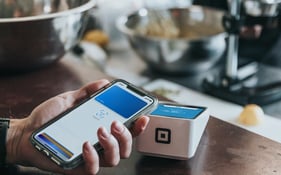In the early days of the pandemic, when everything was shuttered and no one knew anything, people baked sourdough and whipped up cocktails at home. Retail alcohol sales spiked by 20%, and making that Old Fashioned for the ninth Zoom happy hour seemed like fun. Remember the days? We were so young!
As the eons dragged on post-2020, most civilians came to appreciate the merit and skill of the bartender. And restaurant operators have realized once again how lucrative it can be to buy spirits, turn them into something delicious, and hand them to a thirsty patron.
Place to-go cocktails alongside abundant outdoor seating as one of the rare silver linings of restaurant life of late. As dozens of states legalized to-go cocktails, the drinks became a lifeline for struggling bars and restaurants. The push is on in many places to make this emergency measure a permanent legal part of restaurant and bar business.
That means there’s an opportunity to make the mixing and packaging of drinks part of your everyday service. And if you’re going to do it, you might as well do it brilliantly.
How to bottle and package to-go cocktails
We all wanna be fussy about cocktails. The glassware, the ice, the garnish — we carefully curate each for their particular merits, to work in concert. We labor over recipes, tweaking the flavors and proportions and presentation. Unlike chefs, we bartenders have a courtside seat to the reception our creations get. For the customers who take one sip and offer an instant critique — too sweet, too sour, needs more lime, I can’t taste the olive juice — we always have a card up our sleeves, ready to adjust on the fly. To a degree, mixing drinks and sending them out in lidded cups deprives us of that ability. In the to-go game, you have to nail it on the first go.
With all that in mind you have to think strategically. Consider packaging, branding, shelf life, and sustainability. Consider quality. There are limits on what you can accomplish when you let a drink leave your sight, but there are advantages to planning around it. Take sustainable packaging. Instead of slinging plastic or styrofoam, maybe reuse any of the zillion-odd glass bottles you'd otherwise toss out — sterilize those suckers and give them new life! You can get a crown capper for less than $100 and seal everything you send out. Or add a growler-like loyalty component and have “refill” options available, to save you money and encourage return patronage. A couple bucks off for a refill, especially something you have on tap? Genius.
Affixing a custom label on the bottle also makes the experience feel more professional. Cute custom stickers can be had for about 50 cents a pop, from places like Sticker Mule, Sticker Giant, and Sticker You. Postage labels inverted and printed with your branding and the name of the drink also adds some pop. Add instructions if you want: shake, pour over ice, garnish with an orange, the works. Incorporate a QR code that links to a newsletter sign-up if you want to juice your marketing efforts. You know who loves to sign up for things? People halfway through a bangin' cocktail, that’s who.
If the idea of printing and/or ordering stickers isn’t for you, never fear, there are answers for luddites as well. Some card stock, a hole punch and butcher twine, stolen from the back of house (or purchased for $4) can get you cute little labels with customizable info. Get the sous chef with the uncannily cool handwriting to bang out a few, in ink.
How to design recipes and select ingredients for to-go cocktails
So what do we put in these exquisitely packaged drinks? Batched cocktails, ideally. If you work through your recipe thoughtfully to eliminate waste, this approach will be your best friend. But when you work ahead, you also have to think ahead.
Eli Servance III, a New York City bartender and the owner of Distillmatic, offers some advice on how to maximize profitability with your to-go program: Consider using clarified or acid-adjusted juices for a longer shelf life. Your Friday customers will thank you in the event the 50 margaritas you made on Monday are still hanging around because of weather or other unforeseen tomfoolery.
Here’s a handy-dandy chart for acid adjustments, when you want to boost a lower-acid juice (grapefruit, orange, pineapple) into having the body and sting of a higher-acid citrus base.
Grapefruit to lemon — 40 grams citric acid powder
Grapefruit to lime — 27 grams citric acid powder and 13 grams malic acid powder
Orange to lemon — 52 grams citric acid powder
Orange to lime — 32 grams citric acid powder and 20 grams malic acid powder
Pineapple to lemon — 52 grams citric acid powder
Pineapple to lime — 32 grams citric acid powder and 20 grams malic acid powder
Clarifying a juice is even easier: All you need is a strainer and a coffee filter. This is great for presentation, as well. With no pulp in the juice, nothing can settle.
Dilution is the other chemistry to account for. Servance likes to include 20% water, give or take, to account for what would occur in a well-shaken drink he’d pour for you. That dilution is the true secret ingredient in your faves. Negronis, Manhattans, Martinis all have water factored into the flavor profile. The odds of the customer taking a cocktail home, pouring it over ice in a shaker and really giving it a proper shake are … low. You’re their bartender! Do it for them! Don’t skip it!
And while we’re thinking deeply about ingredients, some drinks simply can’t make the trip. The instability of egg whites nix any of the sours: vodka, gin, whiskey, Pisco. Milk-heavy cocktails are trickier, but doable. The unexpected no-no for Servance is the trendy Espresso Martini. “After a few minutes the espresso dies and tastes bitter and weird,” he says. “You can swap for cold brew. But is that still an Espresso Martini?”
These are the questions that keep bartenders up at night after they cork that to-go bottle. Sending your baby out into the world can be an emotional journey. But if you raised her right, she’ll be fine.
[Photo by Helena Lopes on Unsplash]





